The Ninefold Path to Marketing Transformation -- Bill Harvey
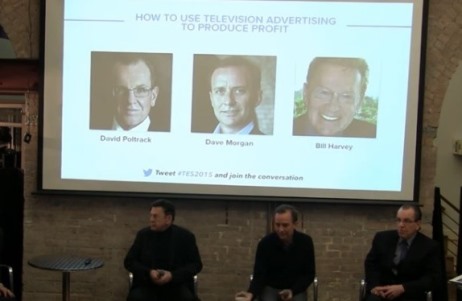
That was the title of my presentation at ARF's special conference at Simulmedia on March 3 with David Poltrack and Dave Morgan. Here's a link to a full video of the conference. In this post I'll summarize my own remarks and include a précis of what David and Dave said from my point of view.
My message is simply this: we can all make more money. Brands can generate more sales without spending more and they can know when to spend more to make a lot more.
Buddha proposed an eight-step path to the Good Life. I have been unable to reduce to below nine steps what I've learned about how to pretty much guarantee the delivery of increased ROI on advertising investments.
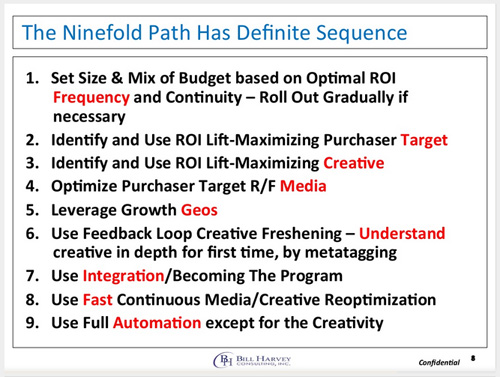
Summing up the State of the Industry, I congratulated all of us on doing a great job. We've become more sophisticated and nimble as a result of adapting to sudden seismic shifts. The Bad News is the general gloom about where the future might leave each one of us personally — will I lose my job as TV loses share to digital? Will agencies go out of business? Even as they are, the pressures have driven many to seek new jobs in different types of companies.
More Bad News is that Acceleritis™ — the accelerating increase of ever-changing information bombardment — makes it hard to focus, with silos and herd mentality becoming de rigueur as people keep their heads down instead of bravely persisting in communicating their own ideas for positive change.
My simple solution to all this is to prove to the client that you caused his/her sales/ROI to go up. This is what will make agencies great again. Of course the direct marketing agencies have always been there. This is also what will increase client retention and attract new business and bonuses for sales/ROI performance and make the agency business profitable and fun again.
This solution will seem to some readers to be easy to say but nearly impossible to do. The really Good News is that — as true as this was — it is no longer true. In the past few years, a small number of us have discovered that it is reliably realistic to promise and deliver increased sales/ROI by taking a few easy steps — nine of them to be exact, but use only one and you'll still get sales increase from advertising. Do all nine and squeeze out every drop of increased sales/ROI. Frankly, doing all nine for every campaign is not going to happen across the board in 2015; it will take years to get there, but in the meantime we can still claim and deliver sales/ROI increase.
The really really Good News is that the reasonable cost of the research that produces this higher sales/ROI can be bundled into the media cost. Digital has been doing this every day for some time now, and this year the upfront will be doing it, led by folks like David Poltrack. Advertisers are even asking for it.
Here's how it's done: you start with a really large sample of homes for which you can measure TV, digital, and purchase. Then without any black box, just transparent direct matching of hard passive data, you look at who's buying more after exposure to the brand's current creative, say Heavy Swing Purchasers (the usual ROI-driving segment in CPG), and then target that purchaser type. That's the one step of our nine that the leaders have been doing for the past couple of years. This has driven up their sales and ROI based on their own bank account validation, not just based on the researcher's data. I showed a graph of nine case studies (see below) that the client has allowed TRA/TiVo Research to publish, where sales lift ranged from 10% to 233%. See all of my 10 slides.
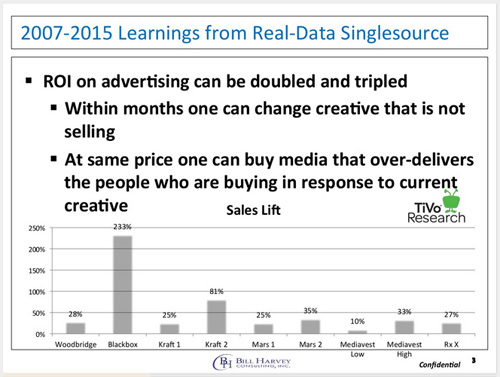
These case studies have also tended to show a large TV sales effect advantage over digital, which should be considered by those who are shifting TV dollars out to digital. David Poltrack pointed out that if TV is raising ROI among the homes it is reaching, why take money out? If digital is going to make incremental sales, why not create incremental budget for it? And as TV reach has dropped for the typical brand that is shifting out of premium TV, if the purchase cycle reach is now 50% and TV is raising ROI among the exposed, why not invest more in TV to reach the other half too? View David Poltrack's slides.
Dave Morgan has been using direct match hard passive Big Data too. Without black box methods, he's matched to advertiser purchase data for targeting and post-evaluation. His data show that in a few short days, TV causes sales increases that alone justify the investment, even before counting the long-term effect of raising sales for years and causing brand loyalty and brand equity. View Dave Morgan's slides.
I also used the opportunity of this forum to share my two newest inventions, Hy-Ops and ScreenSavants, which are directed at two of the least-understood steps of the nine steps on the path to marketing enlightenment:
- Optimizing exploitation of opportunity markets.
Every brand has some hyperlocal areas worth heavy-up, and for brands that have grown large and topped out, the only way they can grow is to tap such areas.
- Deconstructing the "why" of sales-producing creative.
The industry has long needed a way to scientifically study creative, a granular method that can extract the attributes responsible for sales results. This will become a game-changer over the next five years the way direct-match-purchase-media-Big-Data have risen to prominence over the past five years.
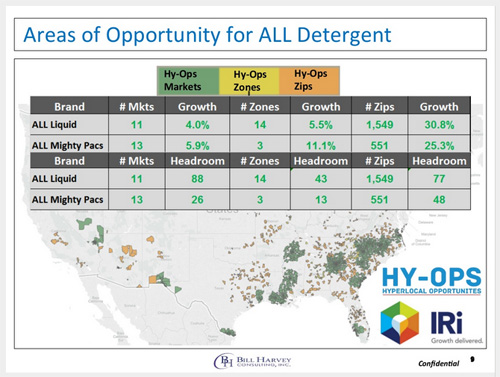
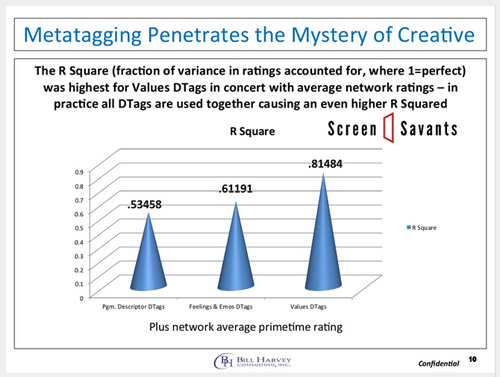
I made four predictions:
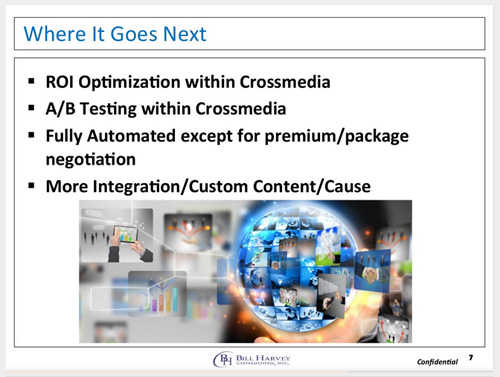
My Nielsen series resumes next week with commentary from Marshall Cohen and Ceril Shagrin.
Bill Harvey is a well-known media researcher and inventor who co-founded TRA, Inc. and is its Strategic Advisor. His nonprofit Human Effectiveness Institute runs his weekly blog on consciousness optimization. Bill can be contacted at bill@billharveyconsulting.com
optimization. Bill can be contacted at bill@billharveyconsulting.com
Read all Bill’s MediaBizBloggers commentaries at In Terms of ROI.
Check us out on Facebook at MediaBizBloggers.com
Follow our Twitter updates at @MediaBizBlogger
The opinions and points of view expressed in this commentary are exclusively the views of the author and do not necessarily represent the views of MediaBizBloggers.com management or associated bloggers. MediaBizBloggers is an open thought leadership platform and readers may share their comments and opinions in response to all commentaries.


